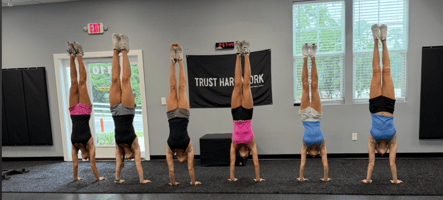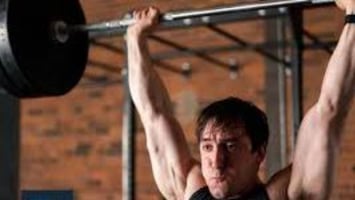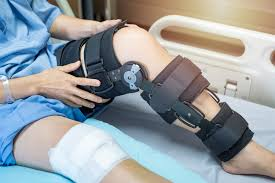Core Control, Spinal Stability, and Smart Recovery for Long-Term Performance In Part 1, the main...
Gymnasts' Guide to Injury Prevention: Protecting Your Back (Part 1)
In the world of gymnastics, strength, flexibility, and control are celebrated—but they also place incredible demands on the spine. Whether it's a back handspring, a dismount, or an arch-heavy tumbling pass, the lower back (lumbar spine) often becomes the unintended workhorse. As a performance physical therapist who works closely with high-level athletes, including gymnasts, I see a recurring pattern: brilliant movement compromised by overuse, faulty mechanics, and under-supported structures.
This guide will break down the most common causes of back injuries in gymnasts, how to recognize warning signs early, and—most importantly—how to build a resilient spine through smart training and recovery.
Why Gymnasts Are Prone to Back Injuries
The spine is designed to move, but gymnastics asks it to do more:
- Hyperextension during backbends, bridges, and back walkovers
- HIGH compressive forces during landings and vaults
- The average compression during landing ranges from 11.6 - 14.8x body weight
- The average compression during landing ranges from 11.6 - 14.8x body weight
- Rotational forces during twisting elements
Address Hip, Thoracic, and Shoulder Mobility to Reduce Compensation
One of the most overlooked causes of low back pain in gymnasts isn’t in the back at all — it’s the lack of mobility in surrounding regions, especially the hips, thoracic spine, and shoulders. When these joints are restricted, the lumbar spine ends up doing the extra work, often resulting in hyperextension, compression, and overuse injuries.
🧠 Why This Matters:
Gymnastics demands extreme positions — bridges, back handsprings, kips, leaps — that require a full kinetic chain working together. If even one link (like hip extension or shoulder flexion) is compromised, the spine compensates with excessive movement.
✅ Hip Mobility
When hip extension is limited (typically due to tight/WEAK hip flexors, quads, or anterior capsule restrictions), athletes arch excessively through the lower back to complete movements like:
- Arabesques
- Back walkovers
- Running into a vault or floor pass
Key mobility targets:
- Hip flexors (iliopsoas and rectus femoris)
– Half-kneeling hip flexor stretches with a glute squeeze, bonus points if you keep your arms overhead to mimic many gymnastics shapes - Quads
– Couch stretch - Glute activation drills
– Ensures the glutes, not the lumbar spine, power hip extension
💡 Assessment tip: If a gymnast can’t achieve a full bridge without their ribs flaring or pelvis tilting anteriorly, they’re likely using their spine instead of their hips.
✅ Thoracic Spine Mobility
The thoracic spine is designed to rotate and extend — but modern posture and overtraining in flexion-based positions can lock it up. When that happens, the lumbar spine compensates again, especially in back handsprings, layouts, and bar work.
Key mobility drills:
- Foam roller thoracic extensions
- Open book stretches or thoracic rotation
- Serratus activation with focus on posterior rib expansion
Goal: Free up the thoracic spine so the lumbar spine doesn’t become a substitute for mobility.
✅ Shoulder Mobility
Shoulders play a direct role in spinal mechanics — especially in overhead skills and weight-bearing positions like handstands and bridges. If a gymnast lacks adequate shoulder flexion or scapular upward rotation, they will compensate by hyperextending the lumbar spine to "create" range.
What to look for:
- In a seated overhead reach, do the ribs flare?
- In a bridge or handstand, do the shoulders fully stack, or is the chest lifted to compensate?
Key mobility targets:
- Latissimus dorsi
– Overhead lat stretch or foam rolling - Teres major and posterior shoulder
– Sleeper stretch or cross-body mobility work - Scapular upward rotation
– Wall slides, serratus wall presses, snow angels
The Mobility Chain in Action
When the hips, thoracic spine, and shoulders move well:
- The lumbar spine can stay stable
- The core can generate force and transfer it efficiently
- Skills become cleaner and safer, with less wear on the low back
Protecting your back isn’t just about the spine — it’s about making sure your hips, shoulders, and upper back are doing their jobs, too. When everything moves the way it’s supposed to, your low back doesn’t have to pick up the slack, and your skills will look and feel so much better. Stay tuned for Part 2 next month, where we’ll dive into core control, spine-friendly strength work, and recovery tips to keep you training hard and feeling great.
In good health,
Dr. Eliza Cohen
Performance Physical Therapist + Wellness Consultant
Wilmington, NC
Follow here for more performance and nutrition tips: @conquermovementpt @doctor_cohen14





-Edit.jpeg?width=50&name=1Q3A9799(2)-Edit.jpeg)
Leave A Comment: